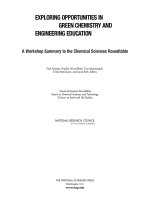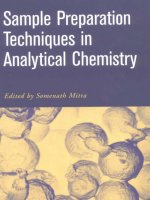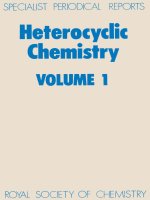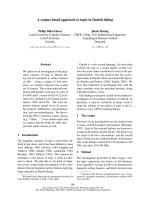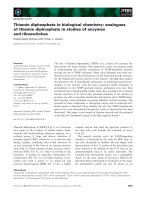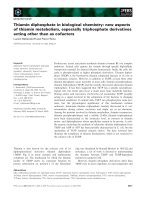Topic in heterocyclic chemistry
Bạn đang xem bản rút gọn của tài liệu. Xem và tải ngay bản đầy đủ của tài liệu tại đây (11.06 MB, 322 trang )
1
Topics in Heterocyclic Chemistry
Series Editor: R. R. Gupta
Editorial Board:
D. Enders · S. V. Ley · G. Mehta · A. I. Meyers
K. C. Nicolaou · R. Noyori · L. E. Overman · A. Padwa
Topics in Heterocyclic Chemistry
Recently Published and Forthcoming Volumes
Bioactive Heterocycles I
Volume Editor: S. Eguchi
Volume 6, 2006
Heterocyclic Marine Products
Volume Editor: H. Kiyota
Volume 5, 2006
QSAR and Molecular Modeling Studies
in Heterocyclic Drugs II
Volume Editor: S. P. Gupta
Volume 4, 2006
QSAR and Molecular Modeling Studies
in Heterocyclic Drugs I
Volume Editor: S. P. Gupta
Volume 3, 2006
Heterocyclic Antitumor Antibiotics
Volume Editor: M. Lee
Volume 2, 2006
Microwave-Assisted Synthesis of Heterocycles
Volume Editors: E. Van der Eycken, C. O. Kappe
Volume 1, 2006
Microwave-Assisted Synthesis
of Heterocycles
Volume Editors: Erik Van der Eycken, C. Oliver Kappe
With contributions by
F. Almqvist · P. Appukkuttan · M. C. Bagley · T. Besson
E. Chorell · S. Crosignani · M. Erdélyi · E. Van der Eycken
N. Kaval · B. Linclau · M. C. Lubinu · B. U. W. Maes
N. Pemberton · M. Rodriquez · M. Taddei · V. Thiéry
123
The series Topics in Heterocyclic Chemistry presents critical reviews on “Heterocyclic Compounds”
within topic-related volumes dealing with all aspects such as synthesis, reaction mechanisms, structure
complexity, properties, reactivity, stability, fundamental and theoretical studies, biology, biomedical
studies, pharmacological aspects, applications in material sciences etc. Metabolism will be also included
which will provide information useful in designing pharmacologically active agents. Pathways involving
destruction of heterocyclic rings will also be dealt with so that synthesis of specifically functionalized
non-heterocyclic molecules can be designed.
The overall scope is to cover topics dealing with most of the areas of current trends in heterocyclic
chemistry which will suit to a larger heterocyclic community.
As a rule contributions are specially commissioned. The editors and publishers will, however, always
be pleased to receive suggestions and supplementary information. Papers are accepted for Topics in
Heterocyclic Chemistry in English.
In references Topics in Heterocyclic Chemistry is abbreviated Top Heterocycl Chem and is cited as
a journal.
Springer WWW home page: springer.com
Visit the THC content at springerlink.com
ISSN 1861-9282
ISBN-10 3-540-30983-7 Springer Berlin Heidelberg New York
ISBN-13 978-3-540-30983-3 Springer Berlin Heidelberg New York
DOI 10.1007/11497363
This work is subject to copyright. All rights are reserved, whether the whole or part of the material
is concerned, specifically the rights of translation, reprinting, reuse of illustrations, recitation, broadcasting, reproduction on microfilm or in any other way, and storage in data banks. Duplication of
this publication or parts thereof is permitted only under the provisions of the German Copyright Law
of September 9, 1965, in its current version, and permission for use must always be obtained from
Springer. Violations are liable for prosecution under the German Copyright Law.
Springer is a part of Springer Science+Business Media
springer.com
c Springer-Verlag Berlin Heidelberg 2006
Printed in Germany
The use of registered names, trademarks, etc. in this publication does not imply, even in the absence
of a specific statement, that such names are exempt from the relevant protective laws and regulations
and therefore free for general use.
Cover design: Design & Production GmbH, Heidelberg
Typesetting and Production: LE-TEX Jelonek, Schmidt & Vöckler GbR, Leipzig
Printed on acid-free paper 02/3100 YL – 5 4 3 2 1 0
Series Editor
Prof. R. R. Gupta
10A, Vasundhara Colony
Lane No. 1, Tonk Road
Jaipur-302 018, India
Volume Editors
Prof. Erik Van der Eycken
Prof. C. O. Kappe
K. U. Leuven
Department of Chemistry
Laboratory for Organic Synthesis
Celestijnenlaan 200F
B-3001 Heverlee, Belgium
Institute of Organic Chemistry
Karl-Franzens University
Heinrichstr. 28
A-8010 Graz, Austria
Editorial Board
Prof. D. Enders
Prof. A.I. Meyers
RWTH Aachen
Institut für Organische Chemie
D-52074, Aachen, Germany
Emeritus Distinguished Professor of
Department of Chemistry
Colorado State University
Fort Collins, CO 80523-1872, USA
Prof. Steven V. Ley FRS
BP 1702 Professor
and Head of Organic Chemistry
University of Cambridge
Department of Chemistry
Lensfield Road
Cambridge, CB2 1EW, UK
Prof. G. Mehta FRS
Director
Department of Organic Chemistry
Indian Institute of Science
Bangalore- 560 012, India
Prof. K.C. Nicolaou
Chairman
Department of Chemistry
The Scripps Research Institute
10550 N. Torrey Pines Rd.
La Jolla, California 92037, USA
and
Professor of Chemistry
Department of Chemistry and Biochemistry
University of California
San Diego, 9500 Gilman Drive
La Jolla, California 92093, USA
VI
Editorial Board
Prof. Ryoji Noyori NL
Prof. Larry E. Overman
President
RIKEN (The Institute of Physical and Chemical Research)
2-1 Hirosawa, Wako
Saitama 351-0198, Japan
and
University Professor
Department of Chemistry
Nagoya University
Chikusa, Nagoya 464-8602, Japan
Distinguished Professor
Department of Chemistry
516 Rowland Hall
University of California, Irvine
Irvine, CA 92697-2025
Prof. Albert Padwa
William P. Timmie Professor of Chemistry
Department of Chemistry
Emory University
Atlanta, GA 30322, USA
Topics in Heterocyclic Chemistry
Also Available Electronically
For all customers who have a standing order to Topics in Heterocyclic Chemistry, we offer the electronic version via SpringerLink free of charge. Please
contact your librarian who can receive a password or free access to the full
articles by registering at:
springerlink.com
If you do not have a subscription, you can still view the tables of contents of the
volumes and the abstract of each article by going to the SpringerLink Homepage, clicking on “Browse by Online Libraries”, then “Chemical Sciences”, and
finally choose Topics in Heterocyclic Chemistry.
You will find information about the
–
–
–
–
Editorial Board
Aims and Scope
Instructions for Authors
Sample Contribution
at springer.com using the search function.
Preface to the Series
Topics in Heterocyclic Chemistry presents critical accounts of heterocyclic compounds (cyclic compounds containing at least one heteroatom other than carbon in the ring) ranging from three members to supramolecules. More than
half of the more than 10000 compounds listed in Chemical Abstracts are heterocyclic compounds. The branch of chemistry dealing with these heterocyclic
compounds is called heterocyclic chemistry, which is the largest branch of
chemistry and as such the chemical literature appearing every year as research
papers and review articles is vast and can not be covered in a single volume.
This series in heterocyclic chemistry is being introduced to collectively
make available critically and comprehensively reviewed literature scattered
in various journals as papers and review articles. All sorts of heterocyclic
compounds originating from synthesis, natural products, marine products,
insects, etc. will be covered. Several heterocyclic compounds play a significant
role in maintaining life. Blood constituents hemoglobin and purines, as well as
pyrimidines, are constituents of nucleic acid (DNA and RNA). Several amino
acids, carbohydrates, vitamins, alkaloids, antibiotics, etc. are also heterocyclic
compounds that are essential for life. Heterocyclic compounds are widely used
in clinical practice as drugs, but all applications of heterocyclic medicines can
not be discussed in detail. In addition to such applications, heterocyclic compounds also find several applications in the plastics industry, in photography
as sensitizers and developers, and the in dye industry as dyes, etc.
Each volume will be thematic, dealing with a specific and related subject
that will cover fundamental, basic aspects including synthesis, isolation, purification, physical and chemical properties, stability and reactivity, reactions
involving mechanisms, intra- and intermolecular transformations, intra- and
intermolecular rearrangements, applications as medicinal agents, biological
and biomedical studies, pharmacological aspects, applications in material science, and industrial and structural applications.
The synthesis of heterocyclic compounds using transition metals and using heterocyclic compounds as intermediates in the synthesis of other organic
compounds will be an additional feature of each volume. Pathways involving the
destruction of heterocyclic rings will also be dealt with so that the synthesis of
specifically functionalized non-heterocyclic molecules can be designed. Each
volume in this series will provide an overall picture of heterocyclic compounds
X
Preface to the Series
critically and comprehensively evaluated based on five to ten years of literature.
Graduates, research students and scientists in the fields of chemistry, pharmaceutical chemistry, medicinal chemistry, dyestuff chemistry, agrochemistry,
etc. in universities, industry, and research organizations will find this series
useful.
I express my sincere thanks to the Springer staff, especially to Dr. Marion
Hertel, executive editor, chemistry, and Birgit Kollmar-Thoni, desk editor,
chemistry, for their excellent collaboration during the establishment of this
series and preparation of the volumes. I also thank my colleague Dr. Mahendra
Kumar for providing valuable suggestions. I am also thankful to my wife Mrs.
Vimla Gupta for her multifaceted cooperation.
Jaipur, 31 January 2006
R.R. Gupta
Preface to Volume 1
The domestic microwave oven is one of the magnificent inventions used in the
kitchen that contributes to simplifying the lives of many people, as the time
for “cooking” an acceptable meal can be reduced to the time it takes to defrost
and heat vacuum-packed food, altogether consuming less than half an hour.
It all started almost 60 years ago when P. Spencer, studying high-power
microwave sources for radar applications, observed the melting of a chocolate
bar in his pocket; at least that is the story told. The first patent in this field was
filed by him in 1946 and one year later the first commercial microwave oven
appeared on the market. We had to wait until 1955 for domestic models, but
by 1976 almost 60% of US households already had a microwave oven.
Soon engineers and researchers realized that this technique possessed interesting applications for food processing, the drying industry, waste remediation,
analytical chemistry, etc. Unfortunately organic chemists had to wait until 1986
before the first two publications concerning the application of microwaves in
organic synthesis appeared in the literature, independently submitted by the
groups of Gedye and Giguere/Majetich. Since then, the number of publications
dealing with microwave-assisted organic synthesis (MAOS) has been growing
steadily, having reached today a total of 2000, consisting of regular papers as
well as several review articles and a few books describing the state of the art of
microwave-assisted synthesis.
Especially since the appearance on the market at the end of the 1990s of dedicated single-mode systems, which are ideally suited for performing reactions
under fully controlled conditions and on a small scale, microwave chemistry is
also steadily finding its way into the labs of the more conservative amongst us.
The main difference between conventional heating and microwave irradiation
is the way the energy is transferred to the medium: in the former case this
occurs via classical conduction, while in the latter an almost instantaneous
transfer of energy to the reactants takes place.
There is still some dispute about how microwave irradiation accelerates
reactions. Besides the generally accepted thermal effects, one believes that there
are some specific (but also thermal) microwave effects, such as the formation of
“hot spots”. There is still some controversy about the existence of non-thermal
(athermal) microwave effects. At the present time, new techniques such as
“cooling while heating” are being investigated and the problem of upscaling
XII
Preface
for industrial purposes has been tackled with the introduction of continuous
and stop-flow microwave systems, although there is certainly still a long way
to go.
In the 1990s the technique of solid-phase organic synthesis (SPOS) became
generally popular, but especially in the medicinal chemistry community, for
lead detection and lead optimization via combinatorial techniques. The combination with microwave irradiation brought an elegant solution for the problem
of the notoriously slower reactions compared to those in solution phase.
The aim of this book is to focus on the application of microwave irradiation in different fields of heterocyclic chemistry. As a result we are very proud
to present eight selected contributions from eminent scientists in the field
and one written by one of the editors (EVdE), dealing with different topics
of heterocyclic chemistry. The first chapter describes the synthesis and functionalization of 2-pyridones, 2-quinolones and ring-fused 2-pyridones. An
overview of microwave-assisted multicomponent reactions for the synthesis
of heterocycles is given in the second chapter, followed by up-to-date reviews
of the synthesis of sulfur and nitrogen-containing heterocycles in the third
contribution, and solid-phase methods for the microwave-assisted synthesis
of heterocycles in the fourth. The use of polymer-supported reagents is thoroughly discussed in the fifth chapter as well as the metal-based carbon–carbon
and carbon–heteroatom bond formation for the synthesis and decoration of
heterocycles. The final chapters are devoted to the synthesis of heterocycles
via microwave-assisted cycloaddition and cyclocondensation reactions and an
overview of 2(1H)-pyrazinone chemistry in solution and on solid support.
On this occasion we would like to thank all authors for sending their excellent
contributions. We also would like to thank Springer for inviting us to be volume
editors and for their valuable support during the production of this volume.
Heverlee and Graz, January 2006
Erik Van der Eycken
C. Oliver Kappe
Contents
Microwave-Assisted Synthesis and Functionalization of 2-Pyridones,
2-Quinolones and Other Ring-Fused 2-Pyridones
N. Pemberton · E. Chorell · F. Almqvist . . . . . . . . . . . . . . . . . .
1
Microwave-Assisted Multicomponent Reactions
for the Synthesis of Heterocycles
M. C. Bagley · M. C. Lubinu . . . . . . . . . . . . . . . . . . . . . . . . .
31
Microwave-Assisted Synthesis
of Sulfur and Nitrogen-Containing Heterocycles
T. Besson · V. Thiéry . . . . . . . . . . . . . . . . . . . . . . . . . . . .
59
Solid-Phase Methods
for the Microwave-Assisted Synthesis of Heterocycles
M. Erdélyi . . . . . . . . . . . . . . . . . . . . . . . . . . . . . . . . . .
79
Synthesis of Heterocycles
Using Polymer-Supported Reagents under Microwave Irradiation
S. Crosignani · B. Linclau . . . . . . . . . . . . . . . . . . . . . . . . . . 129
Transition-Metal-Based Carbon–Carbon
and Carbon–Heteroatom Bond Formation
for the Synthesis and Decoration of Heterocycles
B. U. W. Maes . . . . . . . . . . . . . . . . . . . . . . . . . . . . . . . . 155
Synthesis of Heterocycles via Microwave-Assisted Cycloadditions
and Cyclocondensations
M. Rodriquez · M. Taddei . . . . . . . . . . . . . . . . . . . . . . . . . 213
XIV
Contents
The Chemistry of 2-(1H)-Pyrazinones
in Solution and on Solid Support
N. Kaval · P. Appukkuttan · E. Van der Eycken . . . . . . . . . . . . . . 267
Author Index . . . . . . . . . . . . . . . . . . . . . . . . . . . . . . . . 305
Subject Index . . . . . . . . . . . . . . . . . . . . . . . . . . . . . . . . 307
Top Heterocycl Chem (2006) 1: 1–30
DOI 10.1007/7081_006
© Springer-Verlag Berlin Heidelberg 2006
Published online: 15 February 2006
Microwave-Assisted Synthesis and Functionalization
of 2-Pyridones, 2-Quinolones
and Other Ring-Fused 2-Pyridones
Nils Pemberton · Erik Chorell · Fredrik Almqvist (✉)
Organic Chemistry, Department of Chemistry, Umeå University, 90187 Umeå, Sweden
1
Introduction . . . . . . . . . . . . . . . . . . . . . . . . . . . . . . . . . . .
2
2
2.1
3
2.2
2.3
2.4
Synthesis of 2-Pyridone Containing Heterocycles . . . . . . . . . . . .
Synthesis of 2-Pyridone Containing Heterocycles
Using Conventional Heating . . . . . . . . . . . . . . . . . . . . . . . .
Microwave-Assisted Synthesis of Monocyclic 2-Pyridones . . . . . . . .
Synthesis of 2-Quinolones . . . . . . . . . . . . . . . . . . . . . . . . .
Microwave-Assisted Synthesis of Ring-Fused N-Substituted 2-Pyridones
.
.
.
.
.
.
.
.
3
6
9
13
3
3.1
3.2
3.2.1
3.2.2
3.3
3.3.1
3.3.2
3.4
3.4.1
3.4.2
3.4.3
3.4.4
3.4.5
3.5
3.5.1
3.5.2
Microwave-Assisted Functionalization of 2-Pyridones . . . . . . . . .
Functionalization of 2-Pyridones Using Conventional Heating . . . .
Microwave-Assisted Substitution Reactions via Addition Elimination .
Chloro Dehydroxylation . . . . . . . . . . . . . . . . . . . . . . . . . .
Amino Dehalogenation . . . . . . . . . . . . . . . . . . . . . . . . . .
Microwave-Assisted Substitution Reactions via Electrophilic Reagents
Mannich Reaction . . . . . . . . . . . . . . . . . . . . . . . . . . . . .
Bromination . . . . . . . . . . . . . . . . . . . . . . . . . . . . . . . .
Microwave-Assisted Transition Metal Catalyzed Coupling Reactions .
Suzuki Coupling . . . . . . . . . . . . . . . . . . . . . . . . . . . . . .
Heck Vinylation . . . . . . . . . . . . . . . . . . . . . . . . . . . . . .
Buchwald–Hartwig Coupling . . . . . . . . . . . . . . . . . . . . . . .
Aminocarbonylation . . . . . . . . . . . . . . . . . . . . . . . . . . .
Cyanodehalogenation . . . . . . . . . . . . . . . . . . . . . . . . . . .
Microwave-Assisted Functional Group Transformations . . . . . . . .
Reduction and Hydrolysis of Nitriles . . . . . . . . . . . . . . . . . .
Decarboxylation Reactions . . . . . . . . . . . . . . . . . . . . . . . .
.
.
.
.
.
.
.
.
.
.
.
.
.
.
.
.
.
.
.
.
.
.
.
.
.
.
.
.
.
.
.
.
.
.
15
16
17
17
18
19
19
20
21
21
22
22
23
24
25
25
26
4
Concluding Remarks . . . . . . . . . . . . . . . . . . . . . . . . . . . . . .
27
References . . . . . . . . . . . . . . . . . . . . . . . . . . . . . . . . . . . . . . .
28
.
.
.
.
.
.
.
.
.
.
.
.
.
.
.
.
.
. .
Abstract 2-pyridones are important heterocycles with great applicability in medicinal chemistry and this core structure can be found in compounds with various
biological/medicinal applications. Here we show how microwave-assisted chemistry can
be used to effectively synthesize and functionalize substituted monocyclic 2-pyridones,
2-quinolones and other ring-fused 2-pyridones. The chapter covers recent advancements
in this field mainly describing methods developed with instruments specially designed for
microwave-assisted organic synthesis (MAOS).
2
N. Pemberton et al.
Keywords 2-Pyridone · 2-quinolone · Microwave-assisted reactions ·
Ring-fused 2-pyridone
Abbreviations
BINAP
2,2 -Bis(diphenylphosphino)-1,1 -binaphtyl
BMS
Borane methylsulfide
Bn
Benzyl
Bu
Butyl
dba
Dibenzylideneaceton
DCE
1,2-dichloroethane
DEAD
Diethyl azodicarboxylate
DMA
N,N-dimethylacetamide
DME
1,2-dimethoxyethane
DMF
N, N-dimethylformamide
DMFDMA N, N-dimethylformamide dimethyl acetal
DMFDEA N, N-dimethylformamide diethyl acetal
MAOS
Microwave-assisted organic synthesis
MW
Microwaves
NBS
N-bromosuccinimide
NMP
N-methyl-2-pyrrolidinone
TEA
Triethylamine
TFA
Trifluroacetic acid
THF
Tetrahydrofurane
rt
Room temperature
1
Introduction
This chapter describes microwave-assisted synthesis and functionalization of
heterocycles that all have in common a 2-pyridone moiety. This core structure can be found in numerous biologically active compounds with diverse
medicinal properties and is therefore considered a privileged structure in
the pharmaceutical industry. The compounds represented in Fig. 1 are examples of a cardiotonic agent for the treatment of heart failure 1 [1], a selective farnesyl protein inhibitor 2, currently undergoing human clinical trials
as an orally active antitumor agent [2], and a pilicide 3 that shows novel
antibacterial properties by targeting bacterial virulence. They are also representatives of the three categories of 2-pyridones that will be covered in this
chapter i.e., substituted 2-pyridones 4, 2-quinolones 5 and other ring-fused
2-pyridones 6.
Due to the importance of substituted 2-pyridones, many preparative
methods have been reported (see Sect. 2.1), and some of these, but far from
all, have been further developed into methods suitable for microwave-assisted
organic synthesis (MAOS). Here we describe mainly methods performed
with instruments specially designed for MAOS, thus excluding synthesis per-
Synthesis and Functionalization of 2-Pyridones
3
Fig. 1 Heterocycles bearing a 2-pyridone moiety with wide range of medicinal applications. Amrinone WIN 40680 1 is a cardiotonic agent for the treatment of heart failure.
ZAR-NESTRA 2 is a selective farnesyl protein inhibitor and NP048 3 is a pilicide with
novel antibacterial properties. The 2-pyridones 4, 5 and 6 are schematic representations
of the three categories of 2-pyridones that will be covered in this chapter i.e., substituted
2-pyridones 4, 2-quinolones 5 and other ring-fused 2-pyridones 6
formed in domestic microwave ovens. The experienced user of this technique
will appreciate the fact that synthetic methods developed by conventional
heating are not always directly transformable into MAOS. In this chapter, one
will find examples where for instance the choice of solvent turns out to be
crucial for an effective transformation. The methods described herein contain
both reactions performed in solution as well as on solid supports and examples where different selectivities are obtained using microwave technique
as compared to conventional heating are also shown. The last part of this
chapter describes functionalization of 2-pyridones by microwave-assisted
chemistry involving electrophilic and nucleophilic reagents, transition metal
mediated cross-coupling reactions, and functional group transformations.
2
Synthesis of 2-Pyridone Containing Heterocycles
2.1
Synthesis of 2-Pyridone Containing Heterocycles Using Conventional Heating
The broad range of applications of 2-pyridone containing heterocycles has led
to the development of numerous synthetic methods [3, 4], which dates back
4
N. Pemberton et al.
to 1892 when the oxidation of pyridinium salts to substituted 2-pyridones
was reported (a, Scheme 1) [5, 6]. The close relation to pyridine has been
used in the preparation of 2-pyridones via hydrolysis of 2-fluoro-pyridines
(b, Scheme 1) [7, 8] or pyridine diazonium salts (c, Scheme 1) [9–11]. Many
pathways based upon substituted pyridines can also be found in several approaches towards multi ring-fused natural products, such as Camptothecin
and its analogues (d, Scheme 1) [12, 13].
More general processes rely on variations of the Guareschi–Thorpe reaction [14] where condensations between 1,3-dicarbonyls and cyanoacetamide
yield functionalized monocyclic 2(1H)-pyridones (a and b, Scheme 2) [15,
16]. Unless the carbonyls are sufficiently different in reactivity, the reaction
suffers from poor regioselectivity. The use of 3-alkoxy or 3-amino enones
instead of 1,3-dicarbonyls has proven to be a versatile and reliable synthetic methodology where the 1,4-addition controls the regioselective outcome (c and d, Scheme 2) [17–19].
Other notable methods involve Hetero Diels–Alder reactions [20, 21], and
the reaction of vinyl isocyanates with enamines [22, 23].
N-substituted 2-pyridones can be prepared by N-alkylation, under basic conditions (pKa of the amide proton is ∼ 11). The resulting anion
can then react on either nitrogen or oxygen depending on the conditions employed [24–27]. Also, several direct methods for the construction of N-substituted 2-pyridones have been reported. Two such examples
can be seen in Scheme 3 where the first example (a) is an intramolecular
Dieckmann-type condensation [28] and the second (b) is a metal-mediated
[2 + 2 + 2] reaction between alkynes with isocyanates [29, 30].
Bicyclic 2-pyridones fused over the nitrogen is another important heterocyclic scaffold. In the quest towards the total synthesis of Camptothecin,
Danishefsky and co-workers developed a method where a vinylogous urethane was reacted with 1,3-dicarboxymethoxyallene generated in situ from
dimethyl 3-chloroglutaconate to a bicyclic 2-pyridone intermediate [31–34].
This method has later been successfully applied in the synthesis of other
Scheme 1 A few routes for the synthesis of 2-pyridones from functionalized pyridines
Synthesis and Functionalization of 2-Pyridones
5
Scheme 2 Examples of synthesis of 2-pyridones either from 1,3-diketones (a & b) or from
enaminones (c & d)
Scheme 3 Examples of Dieckmann-type condensation (a) and [2 + 2 + 2] cycloaddition
(b) leading to functionalized and ring-fused 2-pyridones
bicyclic 2-pyridones (a, Scheme 4) [35]. Another elegant approach is the
Rh-catalyzed [3 + 2] cycloaddition between isomünchnone derivatives and
alkenes applied in the synthesis of indolizine alkaloids (b, Scheme 4) [36,
37]. A third example of this category of reactions that result in bicyclic
2-pyridones is a Pd-catalyzed cross-coupling reaction (c, Scheme 4) developed in the Liebeskind laboratories [38].
6
N. Pemberton et al.
Scheme 4 Synthesis of bicyclic 2-pyridones fused over the nitrogen
Obviously, some reactions are more suitable than others to be further developed into microwave-assisted methods. The following sections will cover
some of the latest efforts made in this area but hopefully this previous section
has shown that there are yet many other methods that are transformable into
the more high throughput type of chemistry that MAOS can offer.
2.2
Microwave-Assisted Synthesis of Monocyclic 2-Pyridones
The condensation between enaminones and cyanoacetamide is a wellestablished method for the synthesis of 2-pyridones (see c, Scheme 2,
Sect. 2.1), and the use of malonodinitrile instead of the amide component has also been shown to yield 2-pyridones [39–41]. Recently, Gorobets
et al. developed a microwave-assisted modification of this reaction suitable
for combinatorial synthesis, as they set out to synthesize a small library of
compounds containing a 2-pyridone scaffold substituted at the 3, 5, and
6-positions [42]. The 2-pyridones were prepared by a three-component, twostep reaction where eight different carbonyl building blocks were reacted with
N, N-dimethylformamide dimethyl acetal (DMFDMA) to yield enaminones 7
(Fig. 2). The reactions were performed under solvent-free conditions at el-
Synthesis and Functionalization of 2-Pyridones
7
evated temperatures and gave the desired enaminones in near-quantitative
yields for the majority of the building blocks. Without further purification,
these were then reacted with ten different methylene activated nitriles at
100 ◦ C for 5 min using 2-propanol as solvent and catalytic amounts of piperidine as base. Out of the 80 possible diversely substituted 2-pyridones, 18 were
isolated in moderate to high yields (27–96%), where the pure products 8
could be obtained by simple filtration in most of the cases.
As indicated, many of the more highly functionalized building blocks
did not result in 2-pyridones. However, a thorough structure elucidation of
by-products and intermediates was used to propose a mechanism for the
formation of the 2-pyridone core based on a Michael addition followed by
a “Dimroth-type” rearrangement (Fig. 3).
Another approach towards monocyclic N-unsubstituted 2-pyridones is
based on a solid-phase supported Diels–Alder reaction where a resin-bound
2(1H)-pyrazinone 9 is reacted with acetylenic dienophiles (Fig. 4) [43]. The
initially formed cycloadduct then undergoes a retro Diels–Alder reaction and
depending on the substitution pattern of the starting pyrazinone the reaction
Fig. 2 A library of 18 different functionalized 2-pyridones 8 were synthesized from enaminones 7 using microwave irradiation (single mode) [42]
Fig. 3 Tentative mechanism for the formation of substituted 2-pyridones in the reaction
between enaminones and methylene-activated nitriles
8
N. Pemberton et al.
can take two directions thus rendering product mixtures. Either cyanogen
chloride or isocyanate is lost, resulting in resin bound 2-pyridones 10 or
pyridines 11, respectively (Fig. 4). This method was first developed using conventional heating [44], and the chemistry has been applied in both solution
and on solid-phase. In the case of the resin-bound method, the 2-pyridone is
linked to the resin via the N1 nitrogen, and cleavage under acidic conditions
results in N-unsubstituted 2-pyridones.
It was also shown that the commercially available Wang resin is well suited
for the reaction, but a tailor-made resin (based on syringealdehyde and Merrifield resin) offers milder cleavage conditions. By comparing conventional
heating versus MAOS it was found that similar yields for the cycloaddition
step were obtained, but the cleavage from the resin can be performed under
much milder conditions when microwave irradiation is used, and in some
cases the procedure only works using the microwave technique (Table 1).
The availability of functionalized 2(1H)-pyrazinone in combination with
the use of microwave accelerated solid-phase chemistry constitutes a solid
foundation for generating large libraries of compounds suitable for medicinal
chemistry. The authors have also shown that the scaffold can be further functionalized using the principles of “click-chemistry”, thereby paving the way
towards highly substituted 2-pyridone structures [45–47].
Table 1 Comparison between conventional heating and microwave irradiation for the
cleavage of resin bound 2-pyridones under acidic conditions
Method A: Conventional heating Yield (%) a
Method B: Microwave irrad. Yield (%) a
Wang resin b
Wang resin b
HMP-AM resin c
Syringealdehyde
Resin
R1 = OMe
R1 = Ph
R1 = OMe
R1 = Ph
R1 = OMe
R1 = Ph
40%
28%
–
–
–
–
R1 = OMe
R1 = Ph
c
HMP-AM resin R1 = OMe
R1 = Ph
Syringealdehyde R1 = OMe
Resin d
R1 = Ph
a
a
b
b
Isolated yields over two steps
refluxing in TFA
c resulted in the formation of several
by-products
45%
27%
42%
25%
41%
25%
Isolated yields over two steps
TFA:CH2 Cl2 1 : 2, 120 ◦ C, 40 min
c TFA:CH Cl 1 : 9, 120 ◦ C, 10 min
2 2
d TFA:CH Cl 5 : 95, 120 ◦ C, 10 min
2 2
Synthesis and Functionalization of 2-Pyridones
9
Fig. 4 Solid-phase synthesis of 2-pyridones via a Diels–Alder reaction and subsequent
elimination of cyanogenchloride from the cycloadduct
2.3
Synthesis of 2-Quinolones
One frequently used method for synthesizing 2-quinolones is to react anilines
with malonic esters. This reaction can be difficult to accomplish by conventional methods [48, 49] since high temperatures (250–350 ◦ C) are required for
the generation of an α-oxoketene intermediate 12 (Fig. 6). In a recent example
of this type of reaction, Stadler et al. synthesized 4-hydroxyquinolin-2(1H)ones by using a microwave-assisted procedure (Scheme 5) [50].
The reaction was performed in 1,2-dichlorobenzene, which dissolved the
starting materials but not the product. Consequently, the precipitated product
could be obtained in analytical purity by a simple filtration. The reaction also
works by applying solvent-free microwave irradiation conditions, enlightening some green chemistry opportunities. It is worth noting that by mimicking
the rapid heating obtained by microwave irradiation it is possible to get comparable yields of this type of 2-quinolones with other methods. This was
shown by preheating an oil bath to 290 ◦ C, which resulted in a temperature of
245 ◦ C in the sealed process vial within 3 min, compared to 250 ◦ C for the mi-
Scheme 5 Microwave-assisted synthesis of 2-quinolones
10
N. Pemberton et al.
crowave irradiation method. However, the use of this method for larger scale
reactions is obviously not recommended [50].
The reaction between anilines and malonic esters generates two equiv of
ethanol, which could affect the equilibrium between the starting material and
the product (Fig. 5). Therefore, in a sealed tube reaction, it is necessary to
keep the volume and reactant concentrations low in order to shift the equilibrium towards product formation. Thus, large-scale experiments are not
practical using this procedure (Fig. 5).
On the contrary, if the reaction is carried out using an open vessel technique, there is no pressure built up neither from the solvent nor from the
ethanol formed in the reaction, and as a consequence the reaction can then
be performed in larger scale [51, 52]. In agreement with the suggested mechanism, the synthesis of 4-hydroxyquinolin-2(1H)-ones 13 works best with an
electron-donating group (R, Fig. 5) attached to the anilines. The nucleophilicity of the nitrogen then increases and both the condensation with the malonic
ester as well as the ring closing acylation with the α-oxoketene 12 proceeds
faster (Fig. 5). The presence of an aryl R2 -group offers further conjugation
and product stability resulting in higher yields (Fig. 5) [51].
However, when an electron-withdrawing group, e.g., a trifluoromethyl
group, is attached to the anilines this procedure is not applicable. A way to circumvent this problem was enlightened by Glasnov et al. [53] who treated the
malondianilide 14 with Eaton’s reagent, a 7.7% solution of phosphorus pentoxide in methanesulfonic acid (a, Scheme 6) [54]. This reaction is, however,
sensitive to time, temperature, and concentration. More reactive malondian-
Fig. 5 Tentative mechanism for the formation of 3-substituted 4-hydroxyquinolones 13 in
the reaction between anilines and substituted malonic esters via an α-oxoketene 12
Synthesis and Functionalization of 2-Pyridones
11
Scheme 6 Synthesis of 2-quinolones from 1,3-dicarbonyl compounds
ilides also work excellently with this method and result in 2-quinolones in
isolated yields of 80–90%.
This technique has also been applied in the synthesis of carbostyril analogues 15 and as in the previous example also this reaction is favored by an
electron-rich group in the aniline-ring and an electron-poor group attached
to the electrophilic specie (b, Scheme 6) [55]. The use of microwave irradiation can reduce the reaction times from 18–58 h to 80 min and the products
are generally isolated in high yields and purities.
The methods described for synthesizing 2-quinolones has so far been dependent upon the formation of the intermediate α-oxoketene 12 (Fig. 5).
There are, however, other methods for the formation of 2-quinolones. One
Fig. 6 Microwave promoted intramolecular cyclization of o-vinyl substituted isocyanates
16 leading to 2-quinolones


